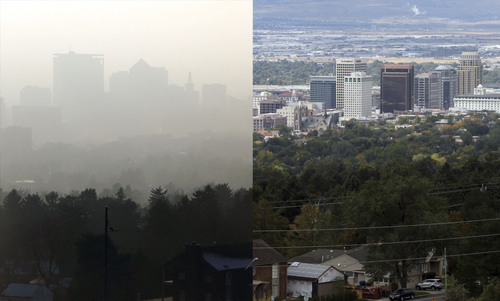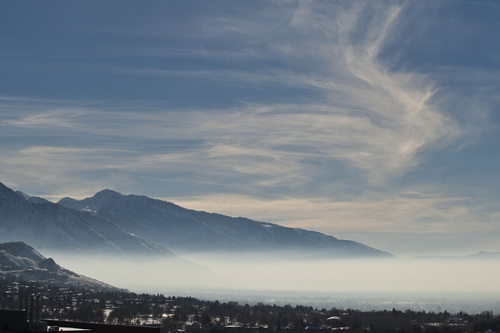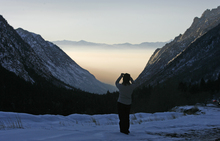This is an archived article that was published on sltrib.com in 2013, and information in the article may be outdated. It is provided only for personal research purposes and may not be reprinted.
While vehicle emissions account for about half of Utah's particulate pollution, countless things we do every day add to a problem that becomes depressingly acute every winter.
That can of hair spray is loaded with volatile organic compounds, or VOCs, that chemically react in the air to become fine particulate. These are the droplets and specks less than 2.5 microns in diameter, so tiny they can penetrate pulmonary tissue. Any chemical product that goes on wet, releases particulate precursors as it dries.
As part of Utah's comprehensive plan to get the air over Salt Lake, Weber and Davis counties into compliance with federal standards for fine particulates, regulators have developed 23 rules targeting hair spray and many other "area sources," such as burning wood, applying varnish and grilling burgers in restaurants.
These new rules, coupled with investments in public transportation and federally mandated improvements in car engines, are expected to get the Wasatch Front into "attainment" with the feds' 24-hour standards for fine particulates by the end of 2019, according to Bryce Bird, director of the Utah Division of Air Quality.
These controls are packaged in a proposed State Implementation Plan, or SIP, that will be the subject of three public hearings over the next week, starting Tuesday in Ogden.
The agency has a separate plan under review for Utah County and has already completed its plan for Cache County, other Utah airsheds that violate the standard for fine particulate matter, set at 35 micrograms per cubic meter.
Some advocates remain frustrated that state officials emphasize achieving compliance with federal standards rather than exceeding them and further clearing the air. Studies show major public health benefits can be realized by reducing emissions even at times when the air quality is relatively good, according to Brian Moench, president of Utah Physicians for a Healthy Environment.
Still, achieving elusive attainment represents an improvement, requiring a large Salt Lake City-area zone to have only 21 days out of compliance over three years. Last winter alone, the five-county zone breached the threshold on 22 days. In 2002, the winter when the world came to Utah to stage the Olympics, it recorded 45 days out of compliance.
The zone includes Salt Lake, Davis, Tooele and parts of Weber and Box Elder counties.
Air quality has improved since then, according to Bird, but clearing out particulate pollution is not straightforward due to the way precursors — nitrous oxides, sulphur dioxide and VOCs — react in the atmosphere. Fine particulate matter is known as PM2.5.
"The chemistry is non-linear. We have seen a 50 percent reduction in precursors in the last 10 years, but [PM2.5 readings] have dropped only 25 percent on the filters," Bird said. "It needs to drop faster in the next five years."
Officials achieve air-quality goals by cutting emissions one ton at a time and have calculated the cost for each ton, which varies greatly depending on the source. The target is to cut 22 tons per day in the five-county Salt Lake non-attainment zone by 2014, ratcheting the cuts up to 64.5 tons by the 2019 deadline for compliance. Wood smoke has a disproportionate impact, according to research by Air Quality Board member Kerry Kelly, a University of Utah chemical engineer. One recent rule change lowers the threshold for PM2.5 that triggers a ban on wood burning. But homes with wood-burning stoves as the sole heat source are exempt from this rule.
About 150 homes in Salt Lake and Davis counties are registered as "sole source" wood-burning homes, yet each of these stoves can emit up to 100,000 times as much direct particulate as a gas furnace.
"They burn wood regardless of what the state says because they think it's sustainable, but it might not be a good fit for our valleys," Kelly said.
Retrofits and controls installed on so-called area sources — such as commercial printers, degreasing equipment and restaurant grills — are expected to achieve some of the biggest gains at the lowest cost, between $238 to $6,560 per ton.
Meanwhile, regulations imposed on industrial polluters, known as point sources, can cost companies tens of thousands per ton in equipment costs, Bird said. A ban on flaring at the North Salt Lake oil refineries is expected to cost an average of $25,000 per ton and Tesoro's NOx scrubber will cut emissions at a cost of $153,000 per ton.
New controls at the five refineries will cut emissions by 2,000 tons by 2019, according to the plan.
Not in the plan are many features clean-air advocates have asked for, such as reduced freeway speed limits and free public transportation on bad air days, a phaseout of wood-burning stoves, and tougher restrictions on industrial emissions. According to Dave McNeill, DAQ planning branch manager, driving slower does not improve emissions or gas mileage in new cars, thanks to design improvements.
"They have to go 70 mph or faster to lose efficiency," McNeill said.
The number of miles people drive isn't as important as the number of trips they take, say officials, who urge stringing multiple errands into a single outing.
"Trip chaining" is just one of numerous practices officials hope Wasatch Front resident embrace for the sake of more breathable air. Other preferred practices focus on purchasing decisions, but the key is to ensure greener products are available in Utah.
Such is the case with hair spray, which California and other states say must contain less than 50 percent VOCs to be sold within their borders. Typical hair sprays often contain more than 80 percent. Many Utah stores do carry the low-VOC versions, but the onus is on you to check the label.
Plan to clear Utah's air
State regulators are hosting three public hearings about a proposed State Implementation Plan, or SIP, designed to get Wasatch Front airsheds into compliance with federal standards for fine particulate air pollution.
A broad, five-county zone that includes the Salt Lake City area breached the 24-hour limit of 35 micrograms per cubic meter 22 times last year. Attaining compliance requires that it exceed the limit no more than 21 times over three years.
The Utah Air Quality Board expects to consider a final version Dec. 4.
The three hearings are scheduled for:
Tuesday: 10 a.m. in Ogden at the Weber-Morgan Health Department, 477 E. 23rd St.
Wednesday: 9 a.m. in Provo at Utah County government offices, 100 E. Center St., Suite 1400
Oct. 15: 10 a.m. in Salt Lake City at the Utah Department of Human Services building, 195 N. 1950 West







